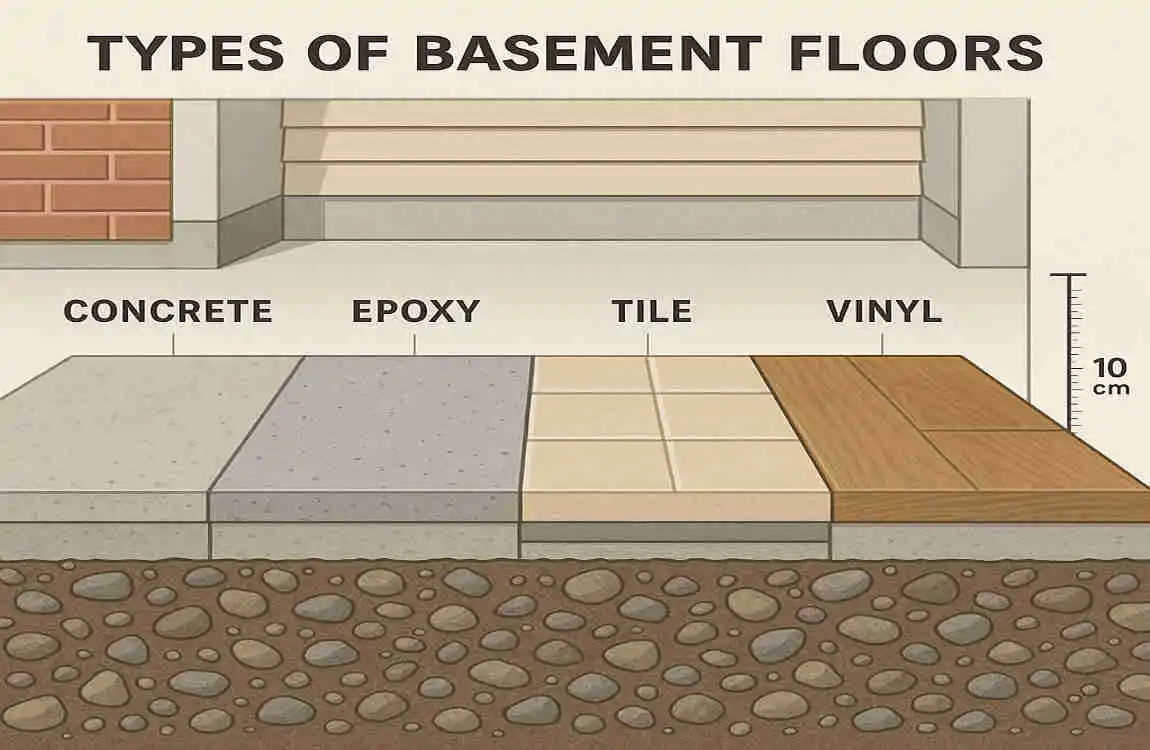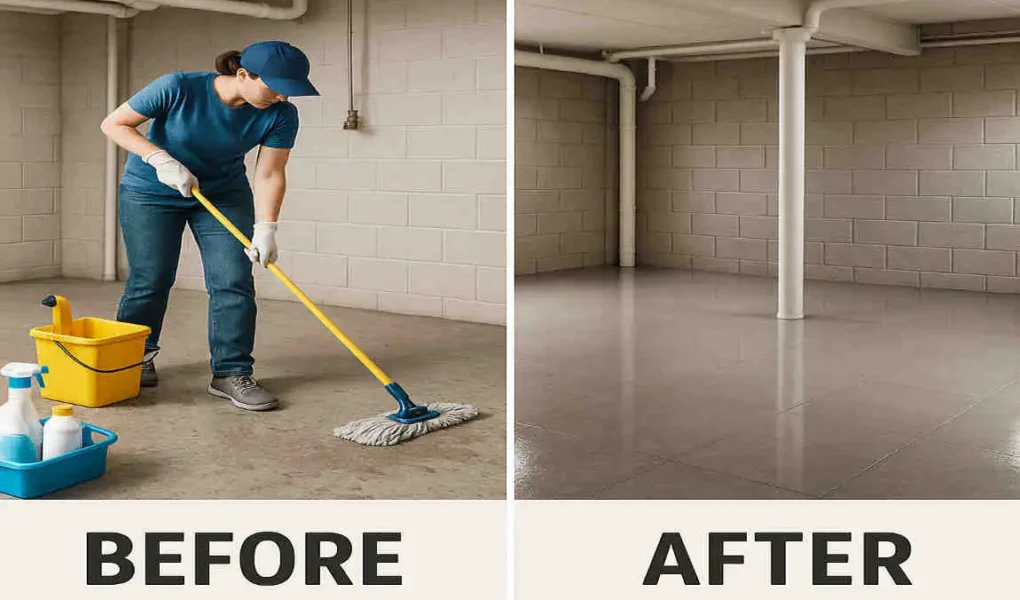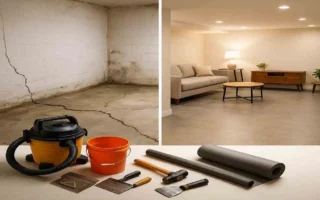Your basement plays an integral role in maintaining your home’s overall health. Whether it’s used for storage, as a living space, or simply as a utility area, a clean and well-maintained basement floor is essential for both hygiene and functionality. Basement floors, however, can easily become neglected. They’re prone to dirt, moisture, and even mold, which can lead to unpleasant odors and unhealthy living conditions.
Understanding Your Basement Floor Type

Cleaning your basement floor starts with understanding the type of flooring you’re dealing with. Different materials require different cleaning approaches. Using the wrong cleaning technique or product can damage your flooring, so identifying the type is crucial.
Common Basement Floor Types
Here are the most common types of basement floors and why their cleaning methods vary:
- Concrete Floors are durable and commonly found in unfinished basements. However, they’re porous and can easily absorb stains.
- Epoxy-Coated Floors: Popular for their glossy finish and stain resistance, but they can scratch if cleaned improperly.
- Tile Floors: Sleek and easy to clean, but require attention to grout lines.
- Vinyl Floors: Affordable and moisture-resistant, though they can discolor if exposed to harsh chemicals.
- Painted Floors: Painted concrete or wood floors are prone to chipping and need gentle cleaning to preserve their finish.
Why Floor Type Matters
Each type of floor reacts differently to cleaning products and techniques. For instance, harsh chemicals can discolor vinyl, while abrasive scrubbers can scratch epoxy finishes. By identifying your floor type in advance, you can select the appropriate cleaning methods and products.
Preparing Your Basement for Cleaning
Before you start scrubbing your basement floor, it’s essential to prepare the space. A little preparation goes a long way toward ensuring effective, efficient cleaning.
Clear the Basement
Remove all furniture, storage boxes, and clutter from the floor. This gives you full access to the surface and ensures nothing gets in the way of your cleaning process.
Address Moisture Issues
Basements are notorious for moisture problems. Before cleaning, inspect your floor for any signs of leaks, standing water, or mold. Fix any issues and dry the area thoroughly to prevent mold and Mildew from spreading.
Gather Your Tools and Supplies
Here’s a checklist of items you’ll need to clean your basement floor effectively:
- Broom, dustpan, and vacuum
- Mop and bucket
- Mild detergent or floor cleaner (specific to your floor type)
- Soft-bristled scrub brush
- Microfiber cloths
- Protective gloves and a mask
- Natural cleaning solutions (like vinegar or baking soda)
- Dehumidifier (optional but helpful for moisture control)
Prioritize Safety
Before you start, ensure proper ventilation to avoid inhaling cleaning fumes, especially in enclosed basement spaces. Wear protective gloves and a mask to shield yourself from dust, mold, and harsh chemicals.
Step-by-Step Guide on How to Clean Basement Floor
Basic Cleaning for Concrete Floors
Concrete basement floors are durable but porous, meaning they collect dust and stains easily. Here’s how to clean them:
- Sweep and Vacuum: Start by removing loose dirt and debris using a broom or vacuum.
- Mop the Floor: Mix a mild detergent with warm water and mop the surface. Avoid soaking the floor, as excess water can seep into the concrete.
- Spot Clean Stains: For stubborn stains, create a paste using baking soda and water. Apply it to the stain, scrub gently, and rinse.
- Rinse and Dry: Use clean water to rinse the surface and wipe it dry with a microfiber cloth.
Cleaning Epoxy and Painted Basement Floors
Epoxy and painted floors require a gentler touch to avoid damaging their finish:
- Dust and Sweep: Use a soft broom or vacuum with a brush attachment to remove dirt.
- Use a Gentle Cleaner: Avoid harsh chemicals. Instead, use a mixture of mild soap and water or a cleaner specifically designed for epoxy surfaces.
- Scrub with Care: Use a non-abrasive scrubber to clean tough spots.
- Dry Thoroughly: Wipe the floor dry to prevent streaking.
Cleaning Tile or Vinyl Basement Floors
Tile and vinyl floors are relatively easy to maintain, but they need special care for grout lines or adhesive-backed vinyl.
- Sweep Regularly: Dust and debris can scratch vinyl or settle into tile grout.
- Mop with the Right Solution: Use a pH-neutral cleaner for tiles or a vinyl-safe product.
- Clean Grout Lines: For tiles, use a toothbrush and baking soda paste to scrub grout lines clean.
- Avoid Harsh Chemicals: Bleach and ammonia can discolor vinyl and damage grout.
Handling Tough Stains and Odors
Common Stains and Removal Methods
Here’s a quick table to tackle tough stains:
Stain Type Removal Method
Oil Stains Sprinkle baking soda, scrub with dish soap, and rinse.
Rust Stains Apply lemon juice and salt, let sit, scrub, and rinse.
Mold or Mildew Use a mixture of vinegar and water, scrub gently, and dry.
Eliminating Musty Odors
Basement odors often stem from moisture. Use a dehumidifier to control humidity and sprinkle baking soda on the floor to neutralize odors.
Maintaining Clean Basement Floors Long-Term

Consistency is key to keeping your basement floor spotless. Here are some tips:
- Regular Cleaning: Sweep and mop weekly to prevent dirt buildup.
- Moisture Control: Use a dehumidifier and seal any cracks to prevent water damage.
- Apply Sealers: Protect concrete and tile floors with a sealant to make cleaning easier.
- Seasonal Care: In humid months, increase ventilation; in winter, clean salt deposits from the floor.
Additional Tips for a Healthy Basement Environment
A clean basement floor is just one part of a healthy basement. Here’s how to maintain the overall environment:
- Control Humidity: Keep humidity levels between 30% and 50% to prevent mold growth.
- Improve Ventilation: Use fans or open windows to circulate air.
- Install Air Filters: Air purifiers can improve air quality and reduce allergens.




